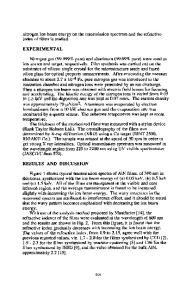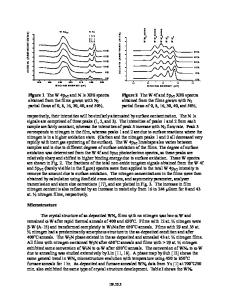Microstructure and Optical Properties of Co Sputter Deposited Si-Al Nanocomposite Thin Films
- PDF / 469,772 Bytes
- 6 Pages / 612 x 792 pts (letter) Page_size
- 19 Downloads / 271 Views
MICROSTRUCTURE AND OPTICAL PROPERTIES OF CO SPUTTER DEPOSITED Si-Al NANOCOMPOSITE THIN FILMS F.Niu1, P.J.Dobson & B.Cantor 1 Department of Materials Science and Engineering and Materials Research Center, Northwestern University, Evanston, Illinois 60208,USA. Oxford Centre for Advanced Materials and Composites, University of Oxford, Oxford, OX1 3PH, UK. ABSTRACT Novel Si-Al nanocomposite thin films were made by radio frequency co-sputtering of Si and Al with Al content from 0 at.% to 69 at.%. Microstructure and optical properties of the films were characterised by conventional and high resolution transmission electron microscopy and spectrometry in the wavelength range from 200 to 3000 nm. The film microstructure consisted of Al nanoparticles (2-9 nm) embedded in an amorphous Si-Al matrix. Optical absorption spectra of the films up to 50 at.% Al exhibited a sharp absorption peak below 500 nm and relatively low absorption above 500 nm. In addition, the absorption peak shifted towards longer wavelengths and the general absorption above 500 nm increased remarkably as Al content increased. For the Si-69 at.%Al films, however, an absorption plateau appeared between 300 nm to 700 nm and a second weak and broad absorption peak appeared at around 900 nm. The results are analysed and compared with the optical absorption predicted by various effective medium theories. INTRODUCTION Nanosized metal and semiconductor particles show novel physical properties which are related to both classical and quantum size effects [1-2]. Nanocomposite thin films consisting of nanosized metal or semiconductor particles (quantum dots) embedded in various matrix materials thus provide a great potential for future optoelectronic devices. Most previous work has been done on nanocermet films in which nanosized metal particles are embedded in different insulator matrix, and only a few investigations have been made on microstructure and optical properties of metal particles embedded in a semiconductor matrix [3-10]. The motivations of the research are similar to those of the studies on Si-Ag nanocomposite thin films [10], i.e. an enhanced interfacial plasma resonance absorption (PRA) from Al nanosized particles is expected in the near ultraviolet (NUV), visible (VIS) or near infrared (NIR). This property may be used to enhance the optical properties of the matrix in which they are embedded. Ag particles have optical properties which are strongly influenced by electron interband transitions [11]. On the contrary, Al is a nearly free electron metal with only a weak electron interband transition around 1.4 eV which corresponds to an electron transition from an s-like band to a p-like band [12]. Thus Al nanoparticles are more likely to show quantum confinement effects in their optical properties. The present study focuses on the microstructures of as-deposited films and their optical absorption characteristics in the NUV, VIS and NIR (200-3000 nm). Effective medium theories (EMTs) have been widely used to predict the optical properties of nanocermet compo
Data Loading...











